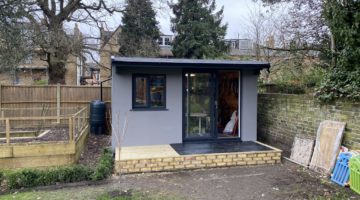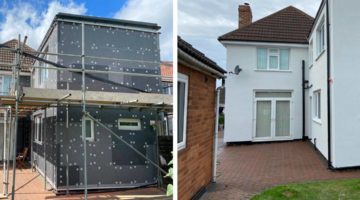
There are plenty of houses in the UK that have been rendered, so its not that hard to work out that rendering can be really beneficial for a property. It can be a little confusing to look at your rendering options for the first time however – there are plenty of different reasons whether or not to render, and many different types to choose from. Here at TheGreenAge, we are going to talk you through your options and decide whether rendering is right for you.
Reasons to render
If you have a typical house with exposed brickwork, why might you want to spend a small fortune rendering your walls?
- Protection – Render is great for protecting your walls. Over the years, brickwork will get damaged and need repointing, and especially in more exposed areas the brickwork is under a constant state of attack from the elements. Rendering creates a protective barrier from the outside world and ensures your brickwork remains unaffected.
- Damp – Solid brick walls are liable to issues from penetrating damp, where water seeps through the brickwork. This is especially the case in exposed areas. Putting a render finish on the wall will help stop this and ensure that penetrating damp is not an issue through the brick.
- Aesthetics – If your brickwork looks tired or tatty, or if you have a mixture of different types of brickwork, rendering can make the property look a lot more attractive. It will freshen up even the roughest-looking wall and make it look modern and clean.
Insulation and render
Until recently you had a simple choice: to render or not. Now it makes sense to insulate your external solid walls and render at the same time. You can find out much more about external wall insulation here.
What type of render should I choose for my home?
So you want to render or externally insulate your home? There are so many types of render out there it can be a bit confusing. Let’s take you through some of the options available to you:
Acrylic render
Acrylic is a relatively cheap render, which makes it a good option if you are on a budget. It also holds vibrant colours for longer, great for instance if you want a nice brick-red render. The disadvantage is that it does not breathe, so if you want air to get to the bricks and insulation underneath, acrylic is not going to work for you. More about Acrylic Render…
Mineral render
Mineral render is breathable, has a quick drying time, is highly impact resistant, and very durable. It falls somewhere in the middle in terms of price, so it a is a good option for many properties. Breathability is obviously very important for some insulation systems, so that can make mineral the preferred option for many of these installs. More About Mineral Render ….
Silicone render
Silicone or silicone silicate render is a top of the range system that has a number of fantastic advantages.
- It is the easiest system to apply. Thin coat silicone renders can be applied to a correctly prepared surface in just a few hours.
- It is hydrophobic (which makes it a self-cleaning render). The silicone render system repels water, meaning any dirt particles are washed away by the rain.
- It is the most flexible system on the market, making cracking over its lifetime less likely. The Silicone render system should be applied along with a fibreglass mesh layer which provides extra flexibility.
- It is highly durable, with some manufacturers offering over 25 years warranty.
- It is breathable. Unlike acrylic and cement renders which seal off the wall, silicone render is breathable.
So, there is very little to say against silicone render. The few drawbacks are that you cannot apply it in cold weather as it takes a while to dry in colder conditions. It is also more expensive than the other types of render – you get what you pay for, as they say! Read More about Silicone render…
How long will render last?
Render will last a long time – the design life is around 30 years, and our partners Be Constructive EWI Ltd will guarantee your render for 25 years. In reality, it should last even longer. There are plenty of rendered properties around the UK that have not needed work for 50 years or more. It really is a long term investment on your property.
Coloured render
Render can be pretty much any colour you like – the pigment is just mixed in with the render. The advantage of doing this is that the colour is much more durable than simply painting the house. A painted wall will peel and lose colour over time, but coloured render will last much longer and provide a much better-looking finish. Read more about Coloured render…
Pebbledash
If there is one relic of the 60s and 70s that some people really hate with a passion it is pebbledash. The great thing about pebbledash render is that it is unbelievably strong. Unfortunately, that also means it is really tricky to strip it off and start again. One way of getting around this is to insulate over the top and then render – this is a great way to avoid the costly exercise of stripping the pebbledash, and you get a great layer of insulation at the same time.
How much does it cost?
Rendering is not a cheap exercise. It will involve scaffolding if you have a two storey or higher wall. If you have existing render it will need stripping, plus it is a fairly labour-intensive job. A typical cost might be £60 per square meter to apply, with an additional cost for stripping render. When you see the cost of external wall insulation at £100 per square meter, it really does make sense to insulate at the same time as render.

Think we missed something? Do you have a different opinion?
Comment below to get your voice heard…












Hi
Wonder if you could help.
My external walls are solid rendered walls.
Internally the walls are cold and suffer from mould. In addition there is some damp under the stairs.
I am considering external thermal insulation using render – is this feasible?
Hi, i have pebbledash on my property and would like to bring it up to date with a smooth render. I have had a couple of quotes from local tradesman who have suggested sand and cement render as this is the classic render and will last? What is the difference between sand and cement render and silicone render you talk about above? Does the silicone render have cement in it?
Bricks are fretting, what plaster should I use?
Hi there, Silicone render is completely different to sand and cement render (and infinitely better) because it is a thin-coat render. This means that it is applied on top of a breathable basecoat at a thickness of about a couple of millimeters. Generally, the thinner the render the more flexibility it will have and therefore less cracking. Silicone render is also self cleaning (so less maintenance) and it is breathable and vapour permeable, so there will be a reduced chance of damp and mould building up on your internal walls. Hope this helps!
Can you put silicone render on top of pebbledash or does it need to be removed first?
A few of these comments reveal a lack of robust analysis of moisture management within a solid structure. And in addition, to the avoidance of the use of fossil-fuel based materials.
Hi Kasmo,
There is a product (https://ewistore.co.uk/shop/ewi-065-one-coat-dash-cover/) that can be applied directly on to pebbledash. You would then put a silicone render on top or simply paint it. If the pebbledash is blown in areas it is defo worth removing first though.
I am interested in getting my property covered with render. I am confused though as the local guys I have got in touch with via checkatrade all take about K-rend, but I want a thin coat silicone render. Not sure if you can shed some light, but I thought K-render was much thicker so now very confused 🙁 Thanks, Sarah
Hi Sarah, we get this query a lot! K-rend is simply a manufacturer of render. Originally they just did the thick render you are taking about (known as monocouche) but they now also offer a product called TC-15 which is a thin coat Silicone render. In my opinion there are lots of advantages for thin coat Silicone renders over and above the older monocouche renders – the main one is that thicker renders are more liable to cracking, which is obviously a big issue. This is not really an attack on K-rend specifically since lots of manufacturers offer their own think coat renders, e.g. Weber, Parex and EWI Pro, but anything that thick will not be able to resist movements in the building. If the render cracks then water ingress through these cracks can lead to all sorts of issues (like the render falling off the wall). The thick, monocouche renders also are more liable to discolouring over time. This is because their surfaces are not hydrophobic, so they absorb water which can lead to the colour leaching out of the render, but also encouraging algae growth. Thin coat renders (like K-rend TC-15 or EWI Pro Silicone render) are flexible so will withstand building movements and therefore are far more resistant to cracking. They also come in what ever colour you want – you are definitely limited when you go with Monocouche. Finally the surfaces of the thin coat renders are hydrophobic so help repel water, hence they are sometimes referred to in the industry as self cleaning. Cost wise, both the different types of render are about the same – so I would defo recommend going for a Silicone render to be honest – help that helps clear up some of the confusion!
Hi James, I had a renderer come around to my property and they said I had stucco on the house. Had a look online and I can’t find out what stucco is and why it is different to other renders. I think I would like to cover it though as it is quite uneven. Is there a product that will make the wall level first and then you render?
Do you do external solid brick wall insulation ?
Thank you
Christine
Hi, we work closely with EWIPro.com, who are our external wall insulation partners. They have an approved list of installers up and down the country.